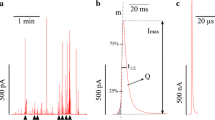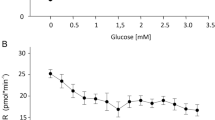Summary
By osmotic lysis in the presence of urea ghosts (60–100 nmol catecholamine/mg prot.) were prepared from chromaffin granules (4–6 μmol catecholamine/mg prot.) of the bovine adrenal medulla. In the presence of 1–300 μmol/l3H-catecholamine and ATP-Mg2+, ghosts show a net uptake of catecholamine. The net uptake is sensitive to reserpine or agents (uncouplers and ammonium) which diminish the electrochemical potential difference for protons at the granule membrane (Δp). The same uptake was found by3H-counting or by fluorimetric measurements. At various pH-values (pH 6.2–82.) theK m andV max of the ATP-stimulated rate of uptake of3H-catecholamine into ghosts was determined (at 30°C) to identify the species of catecholamine (protonated, uncharged, or anionic) which is the substrate for the granule carrier. The pH difference (ΔpH=pHout-pHin) and the electrical potential difference (ΔΨ) were determined to calculate Δp under conditions of3H-catecholamine uptake. When the pHout was increased (pH 6.2, 7.4, 8.2), the apparentK m of uptake decreased (50, 5, 1–2 μmol/l), showing a linear relation between pH and logarithm ofK m. TheK m was calculated for the uncharged catecholamine (with pK1=8.8 and pK2=10.0); it was nearly pH-independent and amounted to about 0.2 μmol/l. TheV max declined only in the extreme pH-range. Between pH 6.6 and 7.8V max and Δp showed a slight increase from 16 to 20 nmoles/(mg prot.·min) and from 110 to 140 mV, resp. In the same pH-range the pHin inside ghosts increased from pH 5.2 to 5.7, whereas ΔΨ was constant (30 mV). At constant pHout (=7.3) ammonium (0–30 mmol/l) caused an increase of pHin from 5.5 to 6.6. The increase of pHin was accompanied by an increase ofK m from 5 to 20 μmol/l3H-catecholamine and by a decrease of bothV max and Δp from 20 to 5 nmoles/(mg prot.·min) and from 123 to 85mV, respectively. From the dependence of theK m of uptake on pHout is concluded that the uncharged species of catecholamine is transported, whereas the dependence ofK m on pHin suggests that the translocation of the catecholamine-carrier complex across the granule membrane is not the rate-limiting step of catecholamine uptake.
Similar content being viewed by others
References
Apps DK, Pryde JG, Phillips JH (1980) Both the transmembrane pH gradient and the membrane potential are important in the accumulation of amines by released chromaffin-granule ‘ghosts’. FEBS Lett 111:386–390
Barlow RB (1983) Biodata handling with microcomputers. Elsevier Science Publishers, Amsterdam, pp 116–121
Burger A, Niedermaier W, Langer R, Bode U (1984) Further characteristics of the ATP-stimulated uptake of calcium into chromaffin granules. J Neurochem 43:806–815
Carty SE, Johnson RG, Vaughan T, Pallant A, Scarpa A (1985) Amine transport into chromaffin ghosts: kinetic measurements of net uptake of biologically and pharmacologically relevant amines using an on-line amperometric technique. Eur J Biochem 147:447–452
Christensen HN (1975) Biological transport. W. A. Benjamin Inc., London, pp 107–123
Deupree JD, Weaver J (1984) Identification and characterization of the catecholamine transporter in bovine chromaffin granules using (3H)reserpine. J Biol Chem 259:10907–10912
Häusler R, Burger A, Niedermaier W (1981) Evidence for an inherent, ATP-stimulated uptake of calcium into chromaffin granules. Naunyn-Schmiedeberg's Arch Pharmacol 315:255–267
Holzbauer M, Sharman DF (1972) The distribution of catecholamines in vertebrates. In: Blaschko H, Muscholl E (eds) Catecholamines. Handbook of experimental pharmacology, XXXIII. Springer, Berlin Heidelberg New York, p 158
Johnson RG, Pfister D, Carty SE, Scarpa A (1979) Biological amine transport in chromaffin ghosts. J Biol Chem 254:10963–10972
Johnson RG, Carty SE, Scarpa A (1981) Proton: substrate stoichiometries during active transport of biogenic amines in chromaffin ghosts. J Biol Chem 256:5773–5780
Johnson RG, Beers MF, Scarpa A (1982) H± ATPase of chromaffin granules. J Biol Chem 257:10701–10707
Johnson RG, Carty S, Scarpa A (1984) Kinetic analysis of the net uptake of biogenic amines into isolated chromaffin ghosts: Changes in theK m andV max as a function of the intra- and extra-vesicular pH. Internat. symposium of molecular biology of catecholamine storing tissues. August 1984, Colmar, France
Knoth J, Handloser K, Njus D (1980) Electrogenic epinephrine transport in chromaffin granule ghosts. Biochemistry 19, 2938–2942
Knoth J, Isaacs JM, Njus D (1981a) Amine transport in chromaffin granule ghosts. J Biol Chem 256:6541–6543
Knoth J, Zallakian M, Njus D (1981b) Stoichiometry of H±-linked dopamine transport in chromaffin granule ghosts. Biochemistry 20:6625–6629
Kobold G, Burger A (1983) Does the granular carrier transport neutral or protonated catecholamines? Naunyn-Schmiedeberg's Arch Pharmacol 322:R 73
Lowry OH, Rosebrough NJ, Farr AL, Randall RJ (1951) Protein measurement with the Folin phenol reagent. J Biol Chem 193:265–275
Palmer JF (1963) The use of β-thiopropionic acid for stabilizing the fluorescence of adrenolutine and noradrenolutine. J Pharm Pharmacol 15:777–778
Mack F, Bönisch H (1979) Dissociation constants and lipophilicity of catecholamines and related compounds. Naunyn-Schmiedeberg's Arch Pharmacol 310:1–9
Martin RB (1971) Zwitterion formation upon deprotonation inl-3,4-dihydroxyphenylalanine and other phenolic amines. J Physic Chem 75, 2657–2661
Njus D, Radda GK (1978) Bioenergetic processes in chromaffin granules — a new perspective on some old problems. Biochim Biophys Acta 463:219–244
Phillips JH (1982) Dynamic aspects of chromaffin granule structure. Neurosci 7:1595–1609
Phillips JH, Apps DK (1980) Stoichiometry of catecholamine/proton exchange across the chromaffin-granule membrane. Biochem J 192:273–278
Scherman D, Henry J-P (1981) pH-dependence of the ATP-driven uptake of noradrenaline by bovine chromaffin-granule ghosts. Eur J Biochem 116:535–539
Scherman D, Henry J-P (1983) The catecholamine carrier of bovine chromaffin granules: form of the bound amine. Molec Pharmacol 23:431–436
Scherman D, Henry J-P (1984) Reserpine binding to bovine chromaffin granule membranes: characterization and comparison with dihydrotetrabenazine binding. Molec Pharmacol 25:113–122
Scherman D, Jaudon P, Henry J-P (1983) Characterization of the monoamine carrier of chromaffin granule membrane by binding of (2-3H)dihydrotetrabenazine. Proc Natl Acad Sci USA 80:584–588
Segel IH (1976) Biochemical calculations. John Wiley & Sons. New York, pp 1–261
Smith AD, Winkler H (1967) A simple method for the isolation of adrenal chromaffin granules on a large scale. Biochem J 103, 480–482
Taugner G (1972) The membrane of catecholamine storage vesicles. Naunyn-Schmiedeberg's Arch Pharmacol 274:299–314
Author information
Authors and Affiliations
Additional information
A preliminary account was presented to the Deutsche Pharmakologische Gesellschaft (Kobold and Burger 1983)
Rights and permissions
About this article
Cite this article
Kobold, G., Langer, R. & Burger, A. Does the carrier of chromaffin granules transport the protonated or the uncharged species of catecholamines?. Naunyn-Schmiedeberg's Arch. Pharmacol. 331, 209–219 (1985). https://doi.org/10.1007/BF00634240
Received:
Issue Date:
DOI: https://doi.org/10.1007/BF00634240




